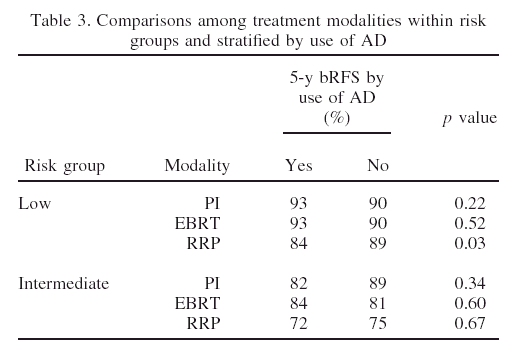| A retrospective comparison of androgen
deprivation (AD) vs. no AD among low-risk and intermediate-risk prostate cancer patients
treated with brachytherapy, external beam radiotherapy, or radical prostatectomy.
Jay P. Ciezki, IJROBP 2004;60:1347 To examine the value of androgen deprivation (AD) in the curative treatment of low- and intermediate-risk prostate cancer treated with the three major modalities: radical retropubic prostatectomy (RRP), external beam radiotherapy (EBRT or RT), and permanent prostate implantation (PI). |
|
| To examine the value of androgen deprivation (AD) in the curative
treatment of low- and intermediate-risk prostate cancer treated with the three major
modalities: radical retropubic prostatectomy (RRP), external beam radiotherapy (EBRT), and
permanent prostate implantation (PI). Methods and materials The efficacy of treatment for prostate cancer in low-risk (initial prostate-specific antigen [iPSA] <10 ng/mL and biopsy Gleason score [bGS] <7) and intermediate-risk patients (iPSA <10 ng/mL and bGS >6 or iPSA >10 ng/mL and bGS <7) as defined by biochemical means is very good across the major treatment modalities During 1996–2001, 1668 patients with low- and intermediate-risk prostate cancer were treated at The Cleveland Clinic Foundation. Only patients with a minimum of 2 years of prostate-specific antigen follow-up were included in the analysis, and biochemical relapse-free survival (bRFS) was used as the endpoint. Patients were grouped according to treatment modality and stratified according to the use of AD.Median follow-up for the entire population was 48 months (range, 24–94 months). Patient characteristics for the low- and intermediate-risk groups, respectively. Approximately 14% of low-risk patients had AD, whereas nearly 41% of intermediate-risk patients had AD. The median duration of AD for PI, EBRT, and RP was, respectively, 6, 6, and 3 months. All PI patients were treated to a radiation dose of 144 Gy. The median dose for EBRT patients was 78 Gy (range, 66.6–83 Gy). Results The overall 5-year bRFS rate was 87.8%. The 5-year bRFS rate for low-risk patients was 89% and for intermediate-risk patients was 79%. For low-risk patients, the 5-year bRFS rates by treatment modality (without AD vs. with AD, respectively) were PI: 90% vs. 93%; EBRT: 90% vs. 93%; and RRP: 89% vs. 84%. For intermediate-risk patients, the 5-year bRFS rates by treatment modality (without AD vs. with AD, respectively) were PI: 88% vs. 82%; EBRT: 81% vs. 84%; and RRP: 75% vs. 72%. None of the comparisons within risk groups or among modalities supports an increased efficacy with the use of AD. |
|

